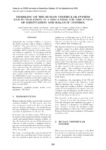Modeling of the human vestibular system and integration in a simulator for the study of orientation and balance control
Title
Modeling of the human vestibular system and integration in a simulator for the study of orientation and balance controlDate
2018Citation
Canelo, A., Tejado Balsera, I., Traver Becerra, J.E., Vinagre Jara, B.M., ; Nuevo Gallardo, C. Modeling of the human vestibular system and integration in a simulator for the study of orientation and balance control. En Actas de las XXXIX Jornadas de Automática, Badajoz, 5-7 de Septiembre de 2018 (pp.636-643). DOI capítulo: https://doi.org/10.17979/spudc.9788497497565.0636 DOI libro: https://doi.org/10.17979/spudc.9788497497565
Versions
http://hdl.handle.net/10662/8517
Abstract
[Abstract] Biologically, the vestibular feedback is critical to the ability of human body to balance in different conditions. This paper presents a human-inspired orientation and balance control of a three degree- of-freedom (DOF) simulator that emulates a person sitting in a platform. In accordance with the role in humans, the control is essentially based on the vestibular system (VS), which regulates and stabilizes gaze during head motion, by means of modeling the behavior of the semicircular canals and otoliths in the presence of stimuli, i.e., linear and angular accelerations/velocities derived by the turns experienced by the robot head on the three Cartesian axes. The semicircular canal is used as the angular velocity sensor to perform the postural control of the robot. Simulation results in the MATLAB/Simulink environment are given to show that the orientation of the head in space (roll, pitch and yaw) can be successfully controlled by a proportional-integral-derivative (PID) with noise filter for each DOF. [Resumen] Biológicamente, la retroalimentación vestibular es crítica para la capacidad del cuerpo humano para equilibrarse en diferentes condiciones. Este artículo presenta una orientación inspirada por el hombre y el control de equilibrio de un simulador de tres grados de libertad (DOF) que emula a una persona sentada en una plataforma. De acuerdo con el papel en los humanos, el control se basa esencialmente en el sistema vestibular (VS), que regula y estabiliza la mirada durante el movimiento de la cabeza, mediante el modelado del comportamiento de los canales semicirculares y los otolitos en presencia de estímulos, es decir, aceleraciones / velocidades lineales y angulares derivadas de los giros experimentados por la cabeza del robot en los tres ejes cartesianos. El canal semicircular se utiliza como sensor de velocidad angular para realizar el control postural del robot. Los resultados de la simulación en el entorno de MATLAB / Simulink se proporcionan para mostrar que la orientación de la cabeza en el espacio (balanceo, inclinación y guiñada) se puede controlar con éxito mediante un derivado proporcional-integral (PID) con filtro de ruido para cada DOF.
Keywords
Vestibular system
Model
Robot
Simulation
MATLAB
Model
Robot
Simulation
MATLAB
Editor version
Rights
Atribución-NoComercial 3.0 España
ISBN
978-84-09-04460-3 (UEX) 978-84-9749-756-5 (UDC electrónico)







